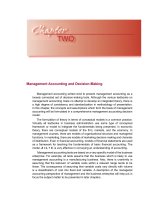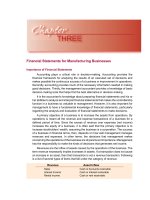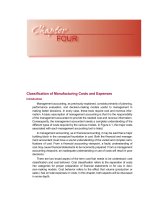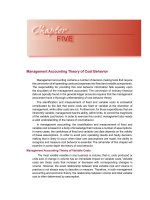Nen Tang Cua Ke Toan Quan Tri Chaper 6
Bạn đang xem bản rút gọn của tài liệu. Xem và tải ngay bản đầy đủ của tài liệu tại đây (659.71 KB, 18 trang )
Management Accounting
| 93
Direct Costing Financial Statements
Purpose
Accounting has evolved slowly over many centuries. The rst important complete
treatise on the principles of accounting and bookkeeping was a book by Pacoli in the
1490s. The development of accounting principles and procedures are still continuing
to evolve. In the early 1900s, many controversial issues were debated and some
were resolved. In the 1950s and 1960s here in the USA, the lack of standardization
in accounting was of primary concern.
One of controversial areas debated extensively in the 1930s and 1940s was the
treatment of manufacturing overhead in the costing of inventory and cost of goods
sold. The controversy was commonly labeled absorption costing versus direct
costing. To understand the issues involved, a good understanding of the principles
of cost accounting is helpful. The purpose of this chapter is to provide a conceptual
foundation for understanding the effect that absorption costing and direct costing
have on net income.
In direct costing, xed manufacturing overhead is treated as an operating expense
(period charge). Absorption costing regards xed manufacturing overhead as a
manufacturing cost properly included in inventory and cost of goods sold. Because
of the difference in the treatment of xed manufacturing overhead, a substantial
difference in the measurement of net income can result.
Accounting for Manufacturing Overhead
Manufacturing overhead is one of the three major manufacturing costs. For the
most part, materials and labor are considered direct costs and can be easily associated
with a specic product or job. However, manufacturing overhead tends to be more
intangible and difcult to trace to a product or job. For example, utility cost such as
power and light is necessary to the production process, but it is not easily assignable
to a product, job, or department. The main solution to distributing overhead cost has
been the use of overhead rates. Rates are typically determined by dividing estimated
overhead cost by some estimated measure of activity. Consequently, the rates are
often called predetermined overhead rates. Activity bases for overhead typically used
94 |
CHAPTER SIX
•
Direct Costing Financial Statements
are direct labor hours, direct labor cost, machine hours, and units of product. The
conventional theory is that direct labor which is easily capable of being measured
correlates directly with the amount of overhead being incurred. If product A has labor
cost of $100,000 and product B has labor cost of $200,000, then 1/3 of the overhead
would be allocated to product A and 2/3 to product B.
However, accountants quickly realized that manufacturing overhead varies in
nature in that some overhead tends to be xed and some tends to be variable. Variable
cost was recognized to be caused by activity and to vary directly with changes in activity.
If production doubled, for example, the variable overhead likewise doubled. However,
xed manufacturing as the term “xed” implies remained the same regardless of the
level of activity. A theory of accounting for xed manufacturing overhead developed
which stated that xed overhead provides the capacity to produce and that the bases
for application of xed manufacturing overhead should be some estimate of capacity.
The cost of buildings, machines, power plants, and some supervisory labor were
labeled capacity costs. Consequently, in cost accounting theory four levels of capacity
were developed: expected actual, normal, practical, and theoretical. Overhead
rates for xed manufacturing overhead were developed by dividing estimated xed
manufacturing overhead by some estimated capacity level. Because the selected
measure of capacity was likely to be much greater than capacity actually utilized, the
use of an overhead rate for xed manufacturing overhead gave rise to under-applied
xed manufacturing overhead.
The methods developed for overhead, particularly xed manufacturing overhead,
at times can have a profound effect on net income. The choice of a capacity base and
the method of application can cause signicant variations in net income. Among cost
accountants, it became quickly recognized that net income was not only a product
of sales but also of the accounting for overhead. If production exceeded sales, then
this difference caused cost of goods sold to be less and net income greater. If the
difference between sales and production decreased, then this fact alone could cause
net income to decrease compared to the previous year.
To illustrate, assume xed manufacturing overhead is $1,000,000 and the
company is debating whether to make 50,000 units or 100,000 units of product. The
estimated xed manufacturing overhead cost per unit of product would, therefore, be
either $10.00 or $20.00. If the company were to actually manufacture 50,000 units
of product, then income would be less because cost of goods sold would be $10 per
product greater. If management is only concerned about short-term maximization of
net income, then the obvious decision would be to make 100,000 units. However,
if sales are only 50,000 and 100,000 units of product are manufactured, an excess
inventory of 50,000 would exist. If the excess inventory is never sold or has to be
sold at a big price decrease, then in the long-term the potential inventory loss could
easily more than offset any short-term benet of over producing. The problem is that
the excess inventory is subject to a carrying cost which over time can be a signicant
out of pocket cost.
The traditional method of accounting for overhead just described is called
absorption costing. The term absorption implies that xed manufacturing is absorbed
Management Accounting
| 95
into the cost of inventory and cost of goods sold by means of using manufacturing
overhead rates. Absorption costing as pointed out by advocates of direct costing has
an inherent and potentially serious aw in that it is possible to manipulate net income
by deliberately manufacturing more units than is required to meet the needs of the
production budget. This aw exists only in regard to xed manufacturing overhead. In
a company with only variable manufacturing overhead, the deliberate act of increasing
production in excess of sales can not cause net income to become larger.
Some accounting theorists in the 1930s and 1940s began suggesting an
alternative method of applying xed overhead to inventory. It was argued that xed
manufacturing costs were not true inventory costs but were periodic costs and that
this charge should be shown on the income statement as an operating expense. Fixed
manufacturing overhead, it was argued, was not caused by the act of producing and,
therefore, could not properly be called a production cost. Since xed manufacturing
overhead tends to remain the same from period to period, treating it as a periodic
charge on the income statement is more appropriate. The proposed solution to the
problem of absorption costing was called direct costing and in some cases variable
costing. The term variable costing was often used because the argument now was that
only variable manufacturing overhead was properly allocated to inventory. However,
the real problem was not variable costs but xed manufacturing overhead.
Most text books on cost accounting have a chapter devoted to discussing
absorption costing versus direct costing. However, it should be pointed out now that
the conict between the two theories for the most part has been resolved in favor
of absorption costing. Authoritative bodies such as the IRS and the FASB have not
approved direct costing as an acceptable alternative for external nancial statement
reporting. However, direct costing is acceptable as part of an internal reporting system
to management. The question that remains today is: is the use of direct costing a
better means of reporting nancial results to management for the purpose of making
decisions?
Absorption Costing Versus Direct Costing
While the main difference between absorption costing and direct costing lies in
the treatment of xed manufacturing overhead, there are consequences that makes
the two methods different in other respects:
Basis Features of Absorption Costing - Absorption costing which is traditional cost
accounting may be summarized as follows:
1. Both xed and variable overhead are applied to inventory (work in
process).
2. Manufacturing overhead is usually applied by means of a predetermined
overhead rate. The single rate, in fact, consists of two rates: a xed
overhead cost rate and a variable overhead cost rate.
3. The use of a predetermined overhead rate generally will result in
manufacturing overhead being over-applied or under-applied.
4. Under-applied overhead is generally charged to cost of goods sold or
shown on the income statement as a separate line item.
96 |
CHAPTER SIX
•
Direct Costing Financial Statements
5. The actual level of production then has an impact on net income. The
greater the level of production relative to sales the less is under-
applied overhead and the greater is net income.
6. The cost of inventory properly includes both xed and variable manu-
facturing overhead.
7. Manufacturing overhead, except for under-applied overhead, therefore,
becomes an expense only when the goods manufactured (nished
goods) are sold.
8. Under absorption costing, net income is a function of both production
and sales.
The advocates of absorption costing, by far the majority viewpoint, argue
strenuously that xed manufacturing cost is a necessary production cost because it
makes production possible and, therefore, must be include in determining the cost
of inventory. To not include xed manufacturing overhead means that the cost of
inventory is understated.
Absorption Costing can be diagramed in T-accounts as follows:
Work in process Finished goods Cost of goods sold Income summary
Material
Variable Overhead
Fixed Overhead
Factory Labor
This diagram shows that before xed manufacturing can be a deduction from net
income it must rst ow through the work in process and nished goods account. To
the extent that nished goods is not sold, the amount of xed manufacturing overhead
in nished goods has been absorbed off the income statement.
Basis Features of Direct Costing - The basic points of direct costing or variable
costing as it is often called may be summarized as follows:
1. Fixed manufacturing overhead is not considered to be a production
cost properly included in the cost of inventory.
2. Fixed manufacturing overhead is regarded as a periodic charge, an
operating expense. Regardless of the level of activity, it remains the
same in a given time period.
Management Accounting
| 97
3. Fixed manufacturing is not caused by production. Even at zero level of
activity, the cost would still remain.
4. An overhead rate is only needed for variable overhead.
5. Because it is a cost of each accounting period and remains the same
independent of production activity, it should be treated as an
expense on the income statement.
6. The treatment of xed manufacturing overhead as a periodic charge
eliminates the distortion to net income caused by uctuations in
production relative to sales.
7. The cost of inventory should only consist of variable manufacturing
costs. Variable overhead should be included in inventory, but not
xed manufacturing overhead.
Direct Costing can be diagramed in T-accounts as follows:
Work in process Finished goods Cost of goods sold Income summary
Material
Variable Overhead
Fixed Overhead
Factory Labor
This cost ow diagram shows that xed manufacturing overhead does not
ow through inventory but rather is a direct charge against revenue on the income
statement. When both cost ow diagrams are compared, the only difference between
direct costing and absorption become quite obvious. The observed difference clearly
is how xed manufacturing overhead is handled. The accounting for variable costs
including variable manufacturing overhead is also obviously the same as in direct
costing.
Effect of Variations in Production Units and Sales Units
In order to fully understand the difference consequences of using absorption
costing as opposed to using direct costing, the effect of production being more or
less than units sold needs to be clearly understood. Some important relationships
are the following:
1. When production units equals sales units, there is no difference in net
income between absorption costing and direct costing. Under this
98 |
CHAPTER SIX
•
Direct Costing Financial Statements
condition, there is no change in the number of units of beginning
and ending inventory.
2. When production (units) is greater than units sold, absorption costing
will show greater net income than direct costing. In this instance, the
inventory of nished goods has increased compared to beginning
inventory Consequently, some xed manufacturing overhead has
been absorbed into inventory.
3. When production is less than units sold, absorption costing will show
less net income than direct costing. In this instance, ending inventory
in terms of units has decreased relative to beginning nished goods
inventory.
4. Under direct costing, assuming sales is constant from period to period,
net income will be the same regardless of the level of production.
5. Under absorption costing, even assuming sales is constant from period
to period, net income will vary directly with changes in production.
If production is increased, then net income will increase and if
production is decreased net income will decrease.
Illustration of Effect of Production Changes on Net Income
In order to illustrate the impact of changes in production on net income, it is
necessary to assume some production data as follows:
Price $40 Variable Cost per unit:
Sales (units) 70 Material $3
Production (units) 80 (case 1) Direct labor $5
Normal capacity 100 units Manufacturing overhead:
Fixed overhead rate ($1,000/100) Variable $2
Other operating expenses $50 Fixed manufacturing overhead $ 1,000
(actual o/h = planned)
A number of important observations can be made from a careful examination of
the income statements for both direct costing and absorption costing (see Figure
7.1).
1.
As production increased by 10 units while sales remained constant,
net income under absorption costing increased by $100 (cases
1 - III). In case IV, net income decreased because production was
less than sales. An increase in production of 10 units causes a $100
decrease in under-applied overhead.
2. Under direct costing, net income remained the same at in all four cases
at $1,050. In direct costing the differences between production and
sales had no effect on net income.
3. In absorption costing, the manufacturing cost per unit is $20 while under
direct costing it is $10. In absorption costing, the total cost includes
$10 per unit for xed manufacturing overhead while in direct costing
none of the xed overhead is included.
Management Accounting
| 99
4. Ending inventory is greater under absorption costing than direct costing
by $10 per unit, the amount of the xed overhead rate. In absorption
costing, xed overhead is included in the cost of inventory whereas
in direct costing it is excluded.
5. The direct costing income statement above was based on cost-
volume-prot principles and clearly delineated all variable and xed
expenses. However, the point needs to be made that this separation
of xed and variable expenses is not a requirement and is strictly an
optional choice. As a matter of practice when direct costing is used,
a separation of xed and variable cost is made and contribution
margin is shown. However, even under absorption costing, variable
and xed costs may be shown.
Absorption Costing Direct Costing
I
II
III
IV
Production (units) 80 90 100 60
Sales (units) 70 70 70 70
Sales $2,800 $2,800 $2,800 $2,800
Expenses
Cost of goods.sold
$1,400 $1,400 $1,400 $1,400
Other expenses
50
50
50
50
Under-applied o/h
200
100
0
400
_____ _____ ______ ______
Total expenses
$1,650
$1,550
$1,450
$1,850
Net income
$1,150
$1,250
$1,350
$950
––––– ––––– ––––– –––––
––––– ––––– ––––– –––––
Ending inventory
$200
$400
$600
$200)
Cost per unit
Material $ 3
Direct labor $ 5
Manufacturing:
Variable rate $ 2
Fixed rate $10
$20
I
II
III
IV
Production (units)
80
90
100
60
Sales (units)
70
70
70
70
Sales
$2,800
$2,800
$2,800
$2,800
Variable Expenses
Cost of goods sold
700
700
700
700
Other variable
0
0
0 0
_____ _____ ____ ____
$ 700
$700
$ 700
$700
_____ _____ ____ _____
Contribution margin
$2,100
$2,100
$2,100
$ 2,100
Fixed expenses
Manufacturing
$1,000
$1,000
$1,000
$1,000
Other operating
50
50
50
50
_____ _____ ____ _____
$1,050 $1,050 $1,050 $1,050
_____ _____ ____ _____
Net income $1,050 $1,050 $1,050
$1,050
_____ _____ ____ _____
_____ _____ ____ _____
Ending inventory
$ 100
$ 200
$ 300
($ 100)
Cost per unit
Material $ 3
Direct labor $ 5
Manufacturing (variable) $ 2
$10
Figure 7.1









